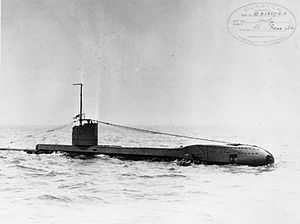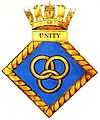HMS Unity (N66)
 HMS Unity | |
| Career | |
|---|---|
| Name: | HMS Unity |
| Builder: | Vickers Armstrong, Barrow-in-Furness |
| Laid down: | 19 February 1937 |
| Launched: | 16 February 1938 |
| Commissioned: | 5 October 1938 |
| Fate: | Sunk 29 April 1940 in accidental collision |
| General characteristics | |
| Displacement: | Surfaced - 540 tons standard, 630 tons full load Submerged - 730 tons |
| Length: | 58.22 m (191.5 feet) |
| Beam: | 4.90 m (16 ft 1 in) |
| Draught: | 4.62 m (15 ft 2 in) |
| Propulsion: | 2 shaft diesel-electric 2 Paxman Ricardo diesel generators + electric motors 615 / 825 hp |
| Speed: | 11.25 knots max surfaced 10 knots max submerged |
| Complement: | 27 |
| Armament: | 4 bow internal 21 inch torpedo tubes, 2 external 10 torpedoes 3 anti-aircraft machine guns |
HMS Unity was a British U class submarine, of the first group of that class, built by Vickers Armstrong, Barrow-in-Furness. She was laid down on 19 February 1937 and was commissioned on 5 October 1938.
She served in home waters in the North Sea, making a failed attack on the German submarine U-2.[1]
Sinking

Unity sailed from Blyth on 29 April 1940 to patrol off Norway. The visibility was down to 300 yards as Unity moved out of the harbour into the main channel, where the Norwegian ship Atle Jarl was proceeding on her way from Scotland to the Tyne. A short while later visibility was down to 100 yards and neither vessel was aware of the other until the submarine spotted the ship at 50 yards and on a collision course. There was just time to shut the bulkhead doors and order the engines astern before the Atle Jarl smashed into the submarine. The order to abandon the submarine was given and Unity sank only five minutes after the collision.[2] Two members of her crew, Lieutenant John Low and able Seaman Henry Miller, gave their lives by remaining behind in the flooded control room so that their shipmates could escape from the sinking vessel.[3]
See also
References
- ↑ HMS Unity, Uboat.net
- ↑ Submarine losses 1904 to present day, RN Submarine Museum, Gosport
- ↑ Gray, Edwyn (1996). Few Survived A Comprehensive Survey of Submarine Accidents and Disasters. London: Leo Cooper. p. 180. ISBN 978-0850524994.
Sources
- Colledge, J. J.; Warlow, Ben (2006) [1969]. Ships of the Royal Navy: The Complete Record of all Fighting Ships of the Royal Navy (Rev. ed.). London: Chatham Publishing. ISBN 978-1-86176-281-8. OCLC 67375475.
- Hutchinson, Robert (2001). Jane's Submarines: War Beneath the Waves from 1776 to the Present Day. London: HarperCollins. ISBN 978-0-00-710558-8. OCLC 53783010.
Coordinates: 55°13′N 1°19′W / 55.217°N 1.317°W
| ||||||||||||||||||||||||||||||||||||||||||||||||||||||